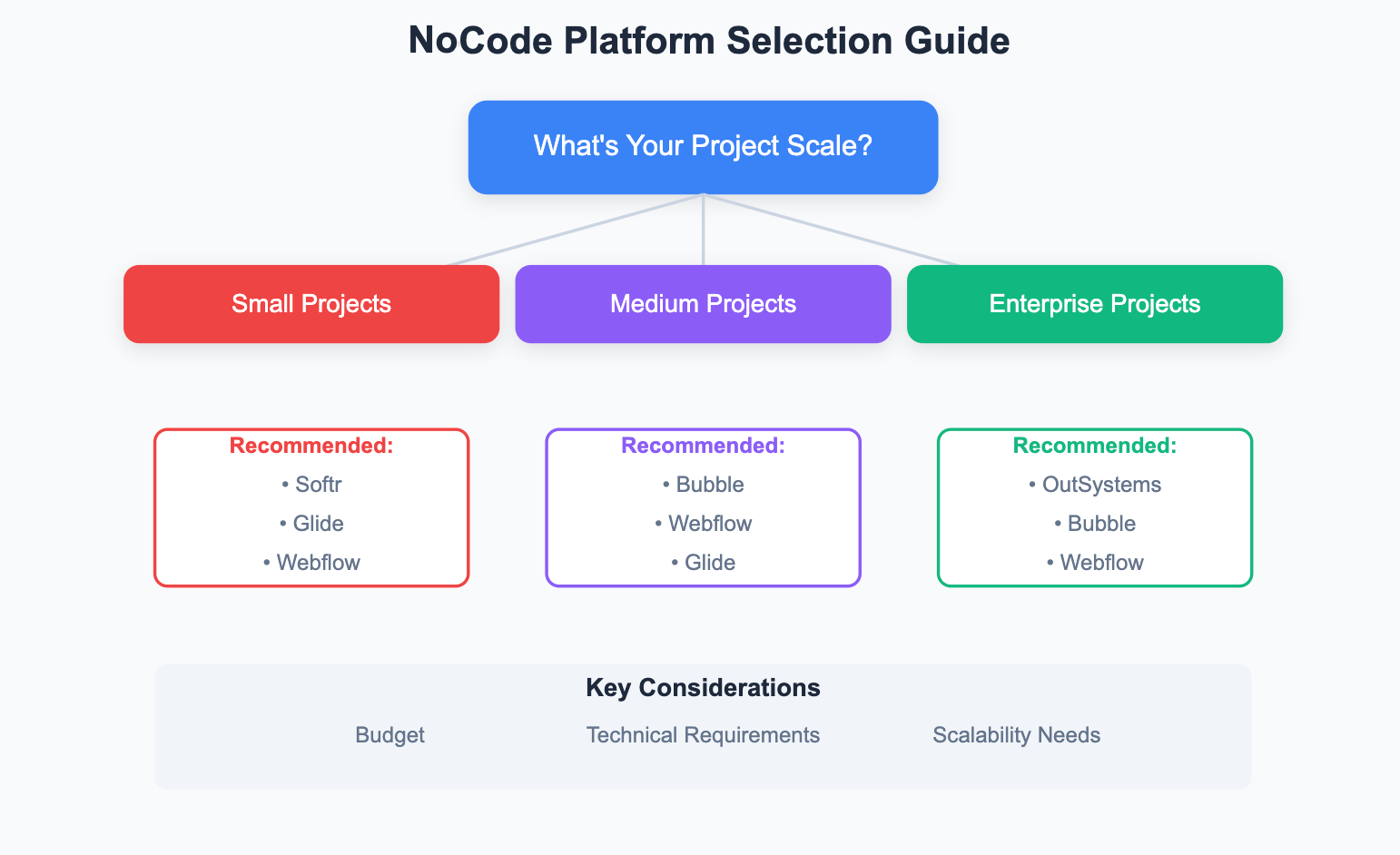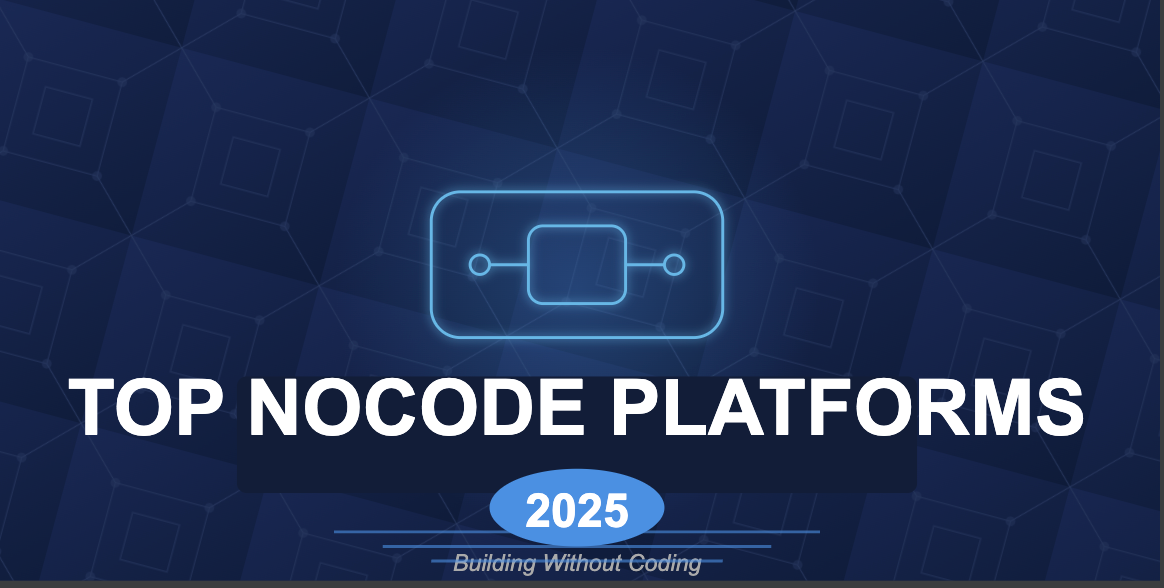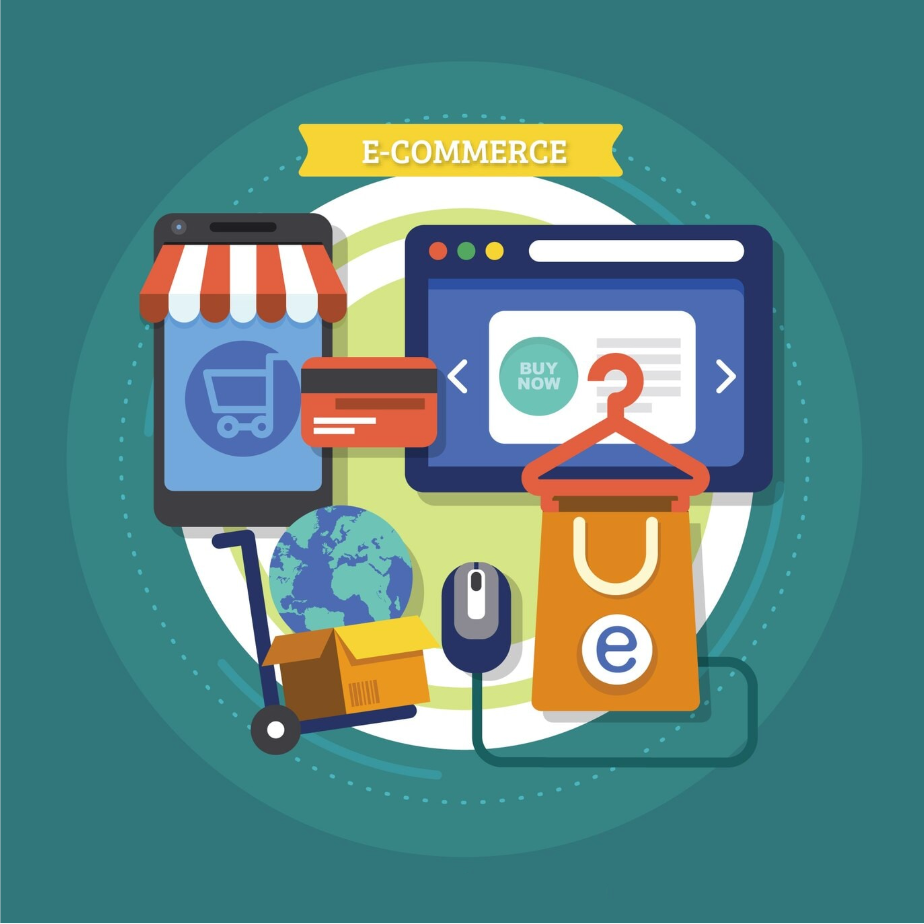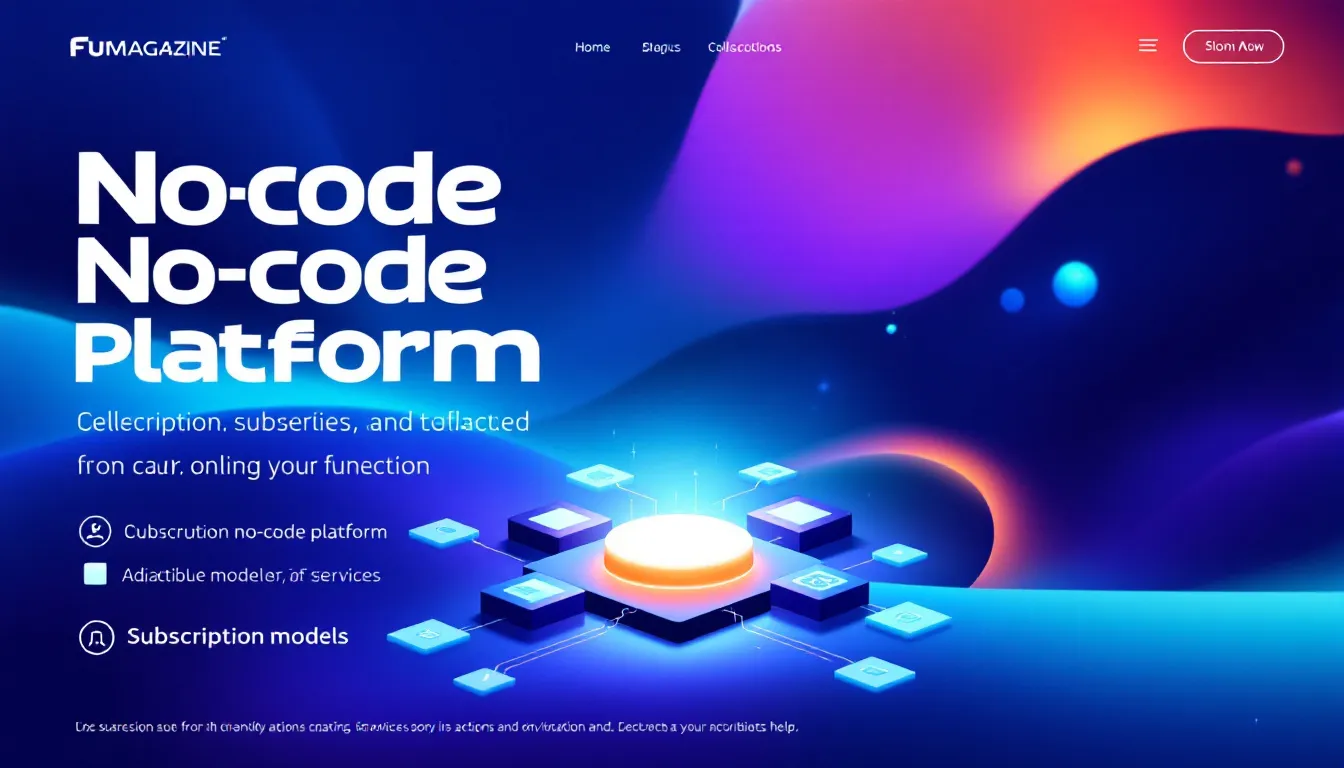

The Ultimate Guide on How to Choose the Best NoCode Platform in 2025
Published on February 25, 2025
Written by Jaren Hidalgo · 10 minute read
Looking for the best NoCode platform in 2025? This article explores the top platforms that generate web applications, hybrid apps, and even native mobile apps, transforming app development, workflow automation, and data management. Expect insights into their capabilities, industry-specific uses, and future trends. Discover the best fit for your business needs without coding expertise.
Key Takeaways
NoCode platforms are now advanced tools capable of creating complex applications, making digital transformation accessible for businesses of all sizes.
Choosing the right NoCode platform requires careful evaluation of project complexity, technical requirements, and available resources to ensure alignment with business needs.
Emerging trends such as AI integration, enhanced collaboration tools, and tailored industry solutions are shaping the future of NoCode development, streamlining application creation.
Overview

In today’s rapidly evolving digital landscape, selecting the right NoCode platform can make the difference between business transformation and stagnation. At Kreante, we’ve implemented hundreds of NoCode solutions across different industries, giving us unique insights into what makes these platforms truly effective in real-world scenarios. While NoCode platforms offer convenience and accessibility, they may not deliver the same level of customization for highly specialized application requirements, highlighting a potential limitation for users with complex needs. However, this is where our LowCode solutions come into play. LowCode platforms offer greater control by combining visual development with coding flexibility, allowing users to incorporate custom scripts. This feature enhances automation and supports complex workflows, making these platforms suitable for addressing intricate business processes and providing a comprehensive solution to meet diverse needs.
NoCode platforms cover a wide array of functionalities such as website and app development, data management, system building, workflow automation, and NoCode development platforms, making them an appealing choice for businesses of all sizes.
What is NoCode Development?

Definition of NoCode Development
NoCode development is a revolutionary approach to software creation that eliminates the need for traditional coding. Instead of writing lines of code, users can build applications by combining and arranging visual elements and objects. This method abstracts the complexities of programming languages, logic, and syntax, making it accessible to a broader audience. Whether you’re a business analyst, or a developer looking to speed up the development process, NoCode platforms empower you to create robust applications with ease.
Benefits of NoCode Development
NoCode development offers a multitude of benefits that make it an attractive option for businesses and individuals alike:
Rapid Application Development: NoCode platforms significantly reduce the time required to build applications. With drag-and-drop interfaces and pre-built components, users can quickly assemble applications, cutting down on development time and costs.
Increased Accessibility: By removing the need for coding skills, NoCode development democratizes application building. Non-technical users can now create sophisticated applications, reducing the dependency on skilled developers and allowing for more diverse input in the development process.
Improved User Experience: The visual interfaces provided by NoCode platforms make it easier to design user-friendly and intuitive applications. Users can see the immediate impact of their changes, leading to better-designed applications that meet user needs.
Greater Customization: NoCode platforms offer a wide range of customization options. Users can tailor their applications to specific business requirements, ensuring that the final product aligns perfectly with their needs.
Cost-Effective: NoCode development reduces the need for extensive coding expertise, allowing businesses to leverage their existing staff for application building. This approach not only saves on development costs but also accelerates the time to market.
Examples of NoCode Development Platforms
Several NoCode development tools and platforms have gained popularity due to their unique features and capabilities:
Bubble: A comprehensive NoCode platform that offers a drag-and-drop interface for building full-stack applications. Bubble is ideal for creating complex business applications with advanced workflow automation and database management.
Airtable: Combines the functionalities of databases and spreadsheets, allowing users to manage and display data in a spreadsheet format. Airtable is perfect for project organization, collaboration, and creating web and mobile apps.
Zapier: Automates tasks by connecting different apps through visual workflows known as “Zaps.” Zapier is excellent for streamlining processes and integrating various tools without coding.
Softr: Builds applications on top of Airtable, supporting data sources like Google Sheets and HubSpot. Softr is user-friendly and ideal for creating quick MVPs and simple applications.
Webflow: A NoCode website builder that combines web design, CMS, and hosting services. Webflow is perfect for designers and developers looking to create visually appealing and content-driven websites.
Adalo: Focuses on mobile app development, providing a range of design components and templates optimized for mobile experiences. Adalo is great for building functional and attractive mobile applications.
To know more please check out or blog post here about NoCode development.
The State of NoCode in 2025
The NoCode landscape has matured significantly, moving beyond basic website builders to sophisticated platforms capable of using custom forms and creating complex business applications. With artificial intelligence integration and advanced automation capabilities, these platforms are revolutionizing how businesses approach digital transformation.
Many NoCode platforms now offer robust tools for building scalable, secure, and feature-rich applications, making them a viable alternative to traditional software development methods, including LowCode platform solutions.
Key Criteria for Choosing a NoCode Platform

Choosing the right NoCode platform involves evaluating several critical factors to ensure it aligns with your business needs. Key decision factors include assessing project complexity, understanding technical requirements, and considering available resources.
Efficiently gathering and utilizing information in app development is essential, as it ensures that data is collected and managed effectively through various platforms. Matching the platform’s capabilities to your project’s demands is crucial, whether you’re building simple websites or complex enterprise applications.
Real-time updates and data synchronization are vital to keep users informed and engaged with the most current information without manual intervention.
Project Complexity
The complexity of your project is a fundamental consideration when selecting a NoCode platform. Simple projects, such as basic content websites and forms, can be effectively built in support of using pre-built templates and functionalities.
Moderate complexity projects, like CRM systems and workflow automation, require platforms that offer more advanced features and customization options for business processes. High complexity projects, including enterprise applications and multi-step processes, require platforms that support extensive workflows and data management capabilities.
Technical Requirements
Grasping the technical requirements of your project aids in selecting the right NoCode platform. These requirements include data processing needs, integration capabilities, security standards, and scalability expectations. Many NoCode platforms claim to support scalability, but their effectiveness can vary significantly.
The platform must handle your data processing needs and integrate seamlessly with your existing systems for long-term success.
Resource and Customization Considerations
Resource considerations encompass budget constraints, team expertise, and timeline requirements. NoCode platforms can significantly lower initial costs compared to traditional methods, making them especially beneficial for startups and small projects. However, it’s important to account for ongoing expenses such as maintenance and hosting, which can accumulate over time.
Your team’s expertise in using NoCode tools impacts both development speed and maintenance capabilities.
Top NoCode Platforms in 2025

The NoCode platform landscape is expected to grow by 40% in 2025, increasing accessibility to app and web development. These platforms cover a wide array of functionalities, from website and app development to data management and workflow automation.
With many NoCode platforms available, it’s essential to understand the strengths and limitations of each to find the best fit for your needs.
Here is a list of the top NoCode platforms for 2025, showcasing various applications and tools.
Bubble
Bubble provides a visual programming language that simplifies app creation, allowing users to design interfaces, manage data, and set workflows without coding. It’s ideal for complex business applications, offering advanced workflow automation, comprehensive database capabilities, and a rich plugin ecosystem.
However, Bubble has a steeper learning curve, which can be a limitation for some users. For those looking to maximize their experience with Bubble, we recommend partnering with Kreante. As a Gold Tier Status member on Bubble, Kreante offers expert guidance and support, ensuring a smoother transition and more effective use of the platform's capabilities.
Webflow
Webflow excels in providing visually appealing and content-driven e-commerce solutions for brands that prioritize design. It automatically generates clean HTML, CSS, and JavaScript, enhancing SEO and improving web design efficiency. Webflow is ideal for professional websites and portals, but it has limitations including limited application logic and basic data management.
Airtable
Airtable merges the functionalities of databases and spreadsheets, making it effective for project organization and collaboration. It’s a versatile tool that can be used to create web apps and mobile apps, automate workflows, and manage data efficiently.
Airtable’s app builder capabilities enable users to develop functional mobile apps without extensive programming knowledge.
Glide
Glide excels in converting spreadsheets into mobile applications, streamlining the app creation process for users. Known for its rapid development capabilities, Glide makes it easy to create data-driven applications with an excellent mobile experience.
However, it has limitations such as template constraints and limited custom code writing options.
Softr
Softr’s user-friendly interface enables rapid deployment of applications, making it particularly suitable for non-technical and business users. It’s ideal for quick MVPs and simple applications, with strengths in fast deployment and ease of use. However, Softr has limitations including limited customization and a basic feature set.
Best NoCode Platforms for Specific Needs

NoCode platforms can handle a variety of application types, including internal tools, e-commerce platforms, and client portals. The choice of code development platforms often depends on the specific needs and complexity of the project.
Here, we explore the best NoCode platforms for these specific applications.
Internal Tools
NoCode platforms are increasingly being adopted for building internal tools, streamlining processes, and enhancing productivity. Bubble is effective for managing intricate workflows, allowing for automation and complex project management.
Glide is also recommended for data-heavy applications due to its efficient data handling capabilities.
E-Commerce Platforms

Bubble is a strong choice for e-commerce platforms requiring high complexity. Webflow excels in providing content-focused solutions for e-commerce websites. Softr is ideal for building straightforward online stores with minimal setup. Traditional coding methods can be time-consuming compared to these o-code solutions, which offer faster deployment and easier maintenance.
Recommendations for e-commerce platforms include Bubble for complex operations, Webflow for content-focused solutions, and Softr for simple stores.
Client Portals
Client portals require a professional presentation and robust functionality. Webflow is recommended for its polished appearance, while Bubble offers interactive features and advanced workflow capabilities.
Softr enables rapid deployment of client portals, making it a suitable choice for quick and straightforward solutions to create websites.
Future Trends in NoCode Development
Emerging trends in NoCode platforms feature AI and machine learning integration, enhanced collaboration tools, and industry-specific solutions. These advancements are making NoCode platforms smarter and more efficient, allowing businesses to create tailored applications without extensive programming knowledge.
AI Integration

Currently, AI and machine learning are enhancing NoCode platforms, making them smarter and more efficient for users. This seamless integration allows for the creation of intelligent applications without coding, emphasizing rapid prototyping and immediate user feedback. The collaboration between AI and NoCode is continuously improving solutions, enabling businesses to innovate and adapt swiftly in today's dynamic environment.
Enhanced Collaboration Tools
Enhanced collaboration tools enable teams to work on NoCode projects more effectively, improving overall productivity and outcomes. Real-time collaboration capabilities, such as co-editing and live feedback, enable team members to contribute simultaneously, ensuring smoother workflows.
Industry-Specific Solutions
The NoCode development landscape is evolving to provide tailored solutions that address specific industry needs, minimizing development barriers for businesses. Platforms like Glide are effective for developing internal tools, while Webflow and Bubble cater to e-commerce and client portal needs respectively.
Expert Tips for Implementing NoCode Solutions
Implementing NoCode solutions successfully requires careful planning and adherence to best practices. Key tips involve thorough planning, following development best practices, and considering security measures throughout the process.
Planning and Learning Phase
Successfully implementing NoCode solutions to create apps starts with clearly defining business objectives and user journeys. Identifying the unique value proposition of the app helps define its core features and target audience.
Creating user personas during planning ensures the software design meets specific user needs.
Development Best Practices
Leveraging AI to automate repetitive tasks and improve decision-making can save time and enhance the user experience. Regular application testing during rapid application development helps identify potential issues early, ensuring a smoother deployment. Implementing these practices leads to robust and scalable NoCode applications.
Security Considerations
Security considerations are crucial in NoCode development. Ensuring compliance with industry standards, robust security measures, data encryption, and user authentication are essential for protecting sensitive data. To dive deeper into how security is managed in a NoCode environment, check out our blog post on "Understanding the Security of Bubble: Building Secure Applications in a NoCode Environment."
Cost Considerations for NoCode Platforms

Cost considerations for NoCode platforms encompass total cost of ownership, platform subscription, additional services, training requirements, maintenance costs, and integration expenses.
Understanding these cost dynamics enables businesses to plan their budgets more effectively when adopting NoCode solutions.
Subscription Models
Grasping the pricing structure of NoCode platforms is crucial for effective budget planning. The total cost of ownership includes both direct costs like subscriptions and indirect costs such as potential training and maintenance.
A clear monetization strategy aligned with the platform’s capabilities is essential for long-term success.
Additional Services
Costs for additional services like training and integrations can vary based on the complexity and requirements of the project. These services can add significantly to the overall expenses of using NoCode platforms.
Factoring in these costs is important when calculating the total cost of ownership.
Total Cost of Ownership
Understanding the cost structure of NoCode platforms is crucial for budgeting, as these can greatly impact long-term project expenses. The total cost of ownership for NoCode applications can rise with user base growth, especially if pricing is based on per user or per component models. Long-term costs include not only subscription fees but also maintenance, support, and potential upgrades.
Defining key performance indicators (KPIs) at the outset can guide the evaluation of the NoCode solution’s success post-implementation.
Conclusion
Choosing the right NoCode platform in 2025 requires careful consideration of your specific needs, resources, and growth plans. Though there is no one-size-fits-all solution, understanding your requirements and evaluating platforms based on project complexity, technical needs, and resource considerations will help you make an informed decision. At Kreante, we not only specialize in NoCode solutions but also offer expertise in LowCode platforms.
This dual capability ensures that regardless of your project requirements, we have the right tools and advice to guide you through any development process. LowCode platforms offer greater control by combining visual development with coding flexibility, allowing users to incorporate custom scripts. This feature enhances automation and supports complex workflows, making these platforms suitable for large-scale business processes. Additionally, LowCode platforms offer a combination of visual builders and custom coding that meet the needs of developers requiring flexibility for advanced applications. With our comprehensive approach, you can confidently tackle any digital transformation challenge.
Need expert guidance in selecting and implementing your NoCode solution? Contact our team at Kreante for a free personalized consultation. We’ve helped hundreds of businesses successfully navigate their digital transformation journey, and we’re ready to help you too. To learn more and stay up to date with the latest news of the NoCode/LowCode domain visit our blog section.
Frequently Asked Questions
What is the meaning of NoCode?
NoCode means you can create applications without needing coding skills, empowering you to build and use tools that enhance your work. Embrace this approach to unlock your creativity and streamline your tasks!
Are NoCode platforms the future?
NoCode platforms are clearly the future, with projections indicating that by 2025, around 70% of new applications will use these technologies. This shift empowers more people to innovate and create solutions, transforming the development landscape for everyone.
How do NoCode platforms benefit businesses?
NoCode platforms are a game changer for businesses, as they drastically cut down on development time and costs while boosting creativity and operational efficiency. By embracing these tools, your business can innovate and thrive!
What is a tip for successful implementation of a NoCode platform?
To successfully implement a NoCode platform, clearly outline your software's objectives, capabilities, and user journey beforehand. This will set you on the path to achieving your goals with confidence! For a comprehensive understanding of project planning, check out our blog post "From Business Agreement to Project Kickoff: Essential Guide for NoCode & LowCode Project Planning." This resource provides valuable insights into preparing for a successful NoCode or LowCode project.
What changes are shaping NoCode platforms in 2025 and beyond?
NoCode platforms are set to evolve with significant changes such as enhanced AI capabilities, superior collaboration tools, and industry-specific solutions. These developments aim to further simplify application building, making it more efficient and accessible for all users,










